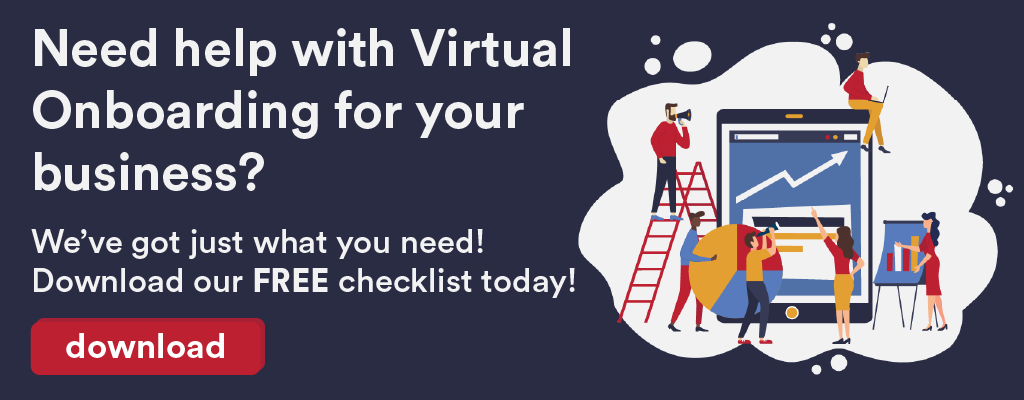Employee onboarding is the process of comprehensively integrating a new employee within your business and its culture, by giving your new hire the tools and information needed to become a productive member of the team.
Not to be confused with employee orientation (which refers to the more immediate job, co-worker, and workplace introduction), employee onboarding is a comprehensive process that can last up to 12 months and involves many people across the business.
Finding and recruiting the best candidates for your organisation is only part of building an effective team. The process of onboarding new employees is one of the most critical factors in ensuring recently hired talent will be productive and engaged on the long term.
But what does an effective onboarding process look like? What should it include and why is it so important? We answer your burning questions below…
What Is Onboarding?
The SHRM defines employee onboarding as “the process of integrating a new employee with a company and its culture, as well as getting a new hire the tools and information needed to become a productive member of the team.”
Whilst this definition remains the same from one company to another, what’s included in the onboarding process may differ.
Traditionally, comprehensive onboarding includes:
– giving your new employee an overview of your company: its people, mission, values, business goals, etc.
– introducing them to their team and peers
– giving them a tour of the office / workspace
– handing over any tools they will need to perform their job (laptop, uniform, etc).
– going over general WHS
– sharing their KPIs and OKRs
– going through relevant training
– and more depending on your business structure
With the above in mind, it is safe to say that onboarding starts from the moment a new hire signs their letter of offer and ends when they start feeling comfortable and being effective in their role.
What Should An Effective Onboarding Process Include?
Whilst the definition of employee onboarding remains the same from one company to another, what’s included in the onboarding process may differ. Ideally, a comprehensive onboarding checklist involves 2 key steps:
1. Employee Orientation
Orientation starts from the moment your new employee signs their letter of offer and generally ends on their first day or at the end of their first week depending on your business. It involves:
– introducing your new hire to their team and peers.
– giving them a tour of their workspace, as well as informing them of any best practices to follow.
– handing over any tools they will need to perform their job (laptop, uniform, etc).
– making them aware of company policies, including but not limited to Work, Health & Safety Procedures (WHS), Performance & Misconduct, Equal Employment Opportunities & Anti-Discrimination, Hours of Work & Absenteeism; Remote Working & Working from Home, Mobile & Internet use, etc.
– going through and signing all relevant new hire paperwork (financial & insurance forms, emergency contact forms, etc.)
2. Employee Engagement
Employee engagement is a much longer process than orientation, and ranges between 90 days (minimum) to a full 12 months. It includes:
– giving your new team member a more in-depth overview of your company: its people, mission, values, business goals, etc. This is done over time, ideally through various mediums such as presentations, one on one meetings with the leadership team as well as a buddy program.
– clarifying their KPIs and OKRs. More specifically what the purpose of their role is within the business and how they will be making a difference.
– going through all relevant training (tools, processes, services or product information, etc.)
– scheduling regular catch-ups and performance reviews so as to give constructive feedback quickly.
With the above in mind, it is safe to say that the onboarding experience starts from the moment a new hire signs their letter of offer and ends when they start feeling comfortable and effective in their role.
Why Is Onboarding Important?
An effective employee onboarding process (virtual or otherwise) has been proven to boost productivity, engagement, and talent retention. It is integral to a strong hiring process.
In fact, a study by analyst firm Aberdeen Group found that 86% of respondents felt that a new hire’s decision to stay with a company long-term is made within the first six months of employment (aka during the onboarding process). Another study reported that about 33% of employees know whether they will stay with their company long-term after only their first week!
Knowing that it takes 27 seconds to make a first impression, this goes to show how important onboarding is and why you’ll want to invest in ensuring your employees’ experience is both positive and smooth from the get-go.
While onboarding isn’t new, this critical period in the employee life cycle is more important than ever. That’s because spending time can mean saving money. All business leaders will be able to agree that both recruitment and staff turnover are expensive exercises.
With the cost of replacing an entry-level employee sitting around 20 to 50% of the person’s annual salary, and reaching up to 150 – 400% for mid and senior-level employees respectively, a solid onboarding goes a long way towards protecting your investment.
And since morale and productivity suffer as a whole with every departure, there is no doubt that onboarding is a key and strategic process for all businesses, and one that should be taken very seriously.
In order to do so, new employees need to be supported and educated over time. This is where a well organised and clear onboarding can make a world of difference, getting people up and running faster and more efficiently.
What Are The Benefits Of Investing In Building A Strong Onboarding?
Further to what’s been mentioned above, here are the key benefits of investing in an efficient and strong onboarding program
1. Reduced Employee Turnover
As mentioned above, replacing talent is both financially expensive and time consuming. But employee turnover doesn’t just affect the bottom line. Culture and job satisfaction are hugely impacted, as well as morale, productivity and lost insider knowledge.
Losing and replacing staff is painful in many ways, so the more comprehensive and solid your onboarding program is, the better chances you have of setting the right foundations for long-term success.
2. Increased Engagement
A Harvard Business Review study found that 71% of participants believed “employee engagement is very important to achieving overall organisational success.” But what does that mean in concrete terms?
Employee engagement is the emotional commitment your employees have towards your business and its goals. This means engaged employees actually care about their work and their company. They don’t work just for a paycheck, or just for the next promotion, but work on behalf of the organisation’s goals. As such, having engaged employees leads to better business outcomes. For instance, according to Towers Perrin research, companies with engaged workers have 6% higher net profit margins, and this but one benefit out of many.
Since an onboarding program’s main goal is to welcome new employees to the business and help them engage in the business culture, it should come as no surprise that its success will determine long-term employee engagement well beyond the onboarding timeline.
3. Increased Productivity
Leaving new hires to their own devices isn’t an effective way to develop competent and productive employees. On the other hand, a successful onboarding program helps new employees feel valued and understand every part of their job.
In fact, employee onboarding results in 54% greater productivity because new hires are able to learn from existing employees and master their roles at a quicker rate.
The length of the onboarding process will also determine the level of an employee’s productivity. Considering it takes new hires 8 to 12 months to gain proficiency compared to their tenured co-workers, staffing and HR experts advise that employee onboarding should last at least one year so as to properly accompany new employees.
Businesses of different sizes spend billions every year on employees who are unproductive because they don’t understand their jobs. Don’t be one of them.
4. Heightened Knowledge Retention
A major part of employee onboarding is the new hire’s learning and development. Onboarding brings job descriptions to life by explaining what’s expected of new employees.
At the end of a strong onboarding process, new employees should be aware of how their role fits into the team and the business as a whole. They should also have an understanding of how things are done and how their role contributes to the overall success of your business.
Employee onboarding should result in the new hire feeling like they’re a valued part of your business and therefore have the motivation to remain on the job while doing their best work.
5. Less Employee Stress
Starting a new role can be stressful for new employees. There’s so much for new hires to consider including whether they will fit in and how to manage their new responsibilities.
Business leaders can reduce the anxiety and stress that their new hires feel through a strong onboarding program which adequately welcomes them to the team and provides them all the tools and information required to do the job.
Employee onboarding should also result in new hires building strong relationships with existing team members. Facilitating good team relationships early will help to reduce any tension in the future by clarifying collaboration best practices.
Final Thoughts
Despite onboarding playing such an integral role in an employee’s success, many HR managers still admit only spending a few hours or a half a day “onboarding” their new hire. Yet, how can new hires be expected to learn the ropes and feel confident enough to produce at maximum potential in such a short amount of time?
Businesses that want employees who perform at maximum potential should view the onboarding experience as an opportune time to invest in their new hire. This is the training ground to get them fully up to speed, a space to create those moments of belonging and the time when new employees transform from new hires to company ambassadors and cheerleaders.
All in all, it’s worth remembering that onboarding is not a single event, it’s an ongoing talent strategy. One that is worth investing in for long term business success.













 July 2, 2020
July 2, 2020 








